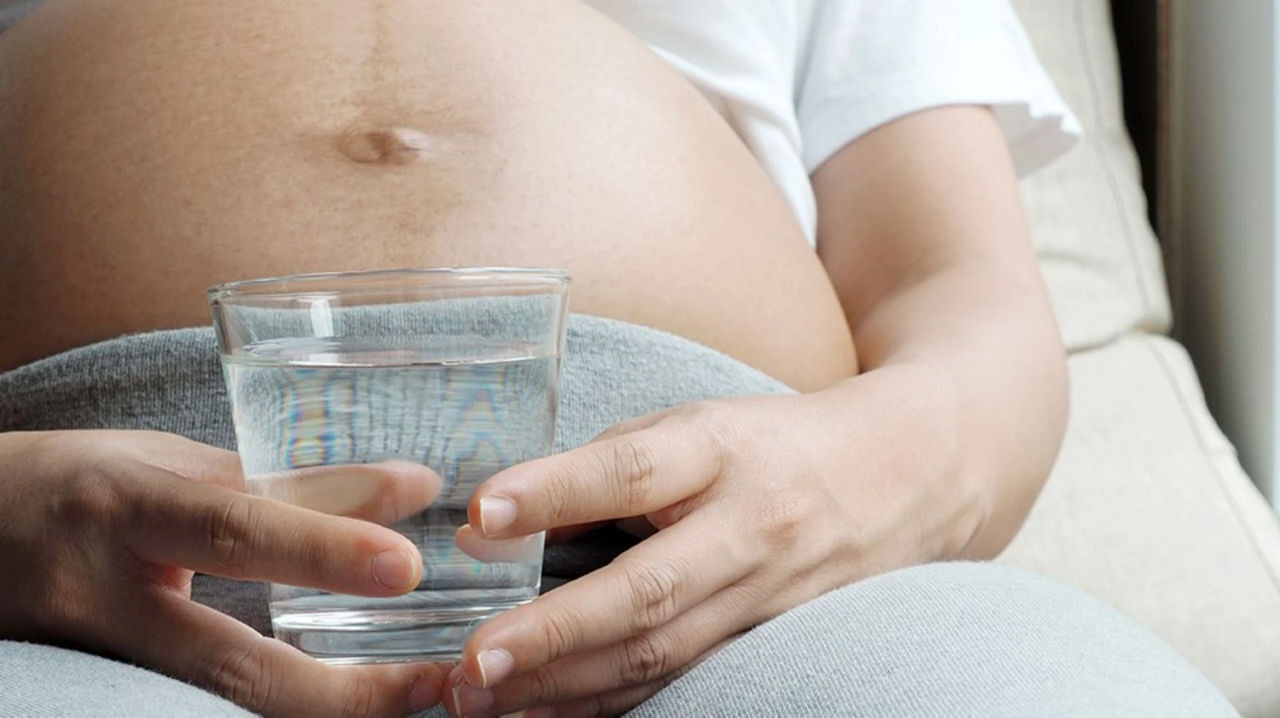By the time you're 36 weeks pregnant, your baby’s digestive system is ready for breast milk. Your growing bump may be putting extra pressure on your bladder at this stage, but it’s still important to drink enough water and stay hydrated. Learn how much you should aim to drink each day and how to tell if you need to up your fluid intake.
36 weeks pregnant

Explore pregnancy stages week by week
Drink up

Your baby's development at 36 weeks
Wow, you might be wondering where the time went all of a sudden! Only 4 weeks until your due date, and 1 week until your pregnancy is deemed to be full-term.
This is a time to wind down at work if you are employed in a job, and also if you are self-employed, or at home with other children. Taking time off over the last few weeks really helps you to feel physically and mentally ready for labour and birth, and gives you time to spend with your partner and/or other children before the all-consuming first few weeks with a newborn. Don’t be surprised if you get what we call ‘nesting’ urges and want to clean and tidy and prepare your home for your impending new family member. Psychologically it feels good to know that you are prepared (especially with your hospital bag!), but it’s ever so important to pace yourself and have time to rest and unwind every day, as well taking the time to practice breathing techniques and/or meditation and hypnobirthing if you have chosen to do these.
If you’re up to it then cook batches of food and freeze for when you come home after the birth, and make sure that you have maternity pads, breast pads and disposable changing mats to hand.
If you are planning to have a vaginal birth then do try and do perineal massage daily, especially if you are having your first baby. You can learn about it from your health professionals, use a specific device if you wish, and watch online videos on how to do it effectively. This is the right time to start and helps to reduce the chance of a tear or episiotomy when you give birth.
How many months is 36 weeks pregnant?
This is already the ninth and final month of pregnancy. However, you may not go into labour until well after your due date. In a normal and healthy pregnancy full-term is defined as 37 until 42 weeks, although if your bay is born between 36-37 weeks, they are likely to be able to breathe and feed as normal.
36 weeks pregnant symptoms
Although your pregnancy bump is still growing, you may actually find that breathing gets easier as your baby’s head goes deeper into the pelvis in preparation for labour. This is less likely if you have had babies before as the baby’s head can drop later on. You might get some pelvic discomfort and backache as this happens, so do wear a pregnancy belt when you walk and see a professional if the pain is unusually severe. It’s not unusual to get mild swelling of your hands and feet, but severe swelling is not normal and must be checked by your midwife or doctor, especially if associated with headaches/blurred vision/severe tummy pain (these can all be signs of dangerously high blood pressure or pre-eclampsia).
As the pelvic floor muscles are relaxing in preparation for labour, and the baby’s head is moving down in your pelvis, you will be passing urine more often and even having the odd leak of urine on coughing or laughing or exercising. It’s really important to do regular pelvic floor exercises and seek help if there’s pain when you pass urine. Sleep may be harder – remember to fall asleep on your left side to help with maintaining a good blood supply to your baby, but don’t panic if you wake up in the night on your back or right side.
Symptoms not to ignore when you’re 36 weeks pregnant
Please seek help and advice from your health care professional if:
- You are worried that your baby is moving less than usual
- You have a persistent headache or visual disturbance
- If your feet/ankles/hands or face are unusually swollen
- You experience vaginal bleeding
- You have an unusual coloured discharge
- You think that your waters have gone
- You have severe abdominal pain or regular painful tightenings
- You have a temperature/difficulty breathing, or chest pain
- You have a hot or swollen calf
On and off period pains at 36 weeks pregnant
It's normal to have more frequent Braxton Hicks tightenings as you approach full term, which some women describe as similar to period pain/cramps. However, if they are very uncomfortable and come regularly every 5 minutes for over an hour or are associated with watery discharge or bleeding, do go in to the maternity triage and get checked.
Pelvic pain at 36 weeks pregnant
As your bump gets larger and baby’s head goes further down into your pelvis, you will notice some mild pelvic discomfort. Try and rest, sit on a birthing ball when reading or watching tv and wear a pregnancy belt when walking. If pains becomes severe, do go in and get checked by your midwife.
Discharge at 36 weeks pregnant
This is already the ninth and final month of pregnancy. However, you may not go into labour until well after your due date. In a normal and healthy pregnancy full-term is defined as 37 until 42 weeks, although if your bay is born between 36-37 weeks, they are likely to be able to breathe and feed as normal.
Cramps at 36 weeks pregnant
they become very painful or regular go in to the hospital and get checked as you could be going in to labour.
Diarrhoea at 36 weeks pregnant
As your bump gets larger and baby’s head goes further down into your pelvis, you will notice some mild pelvic discomfort. Try and rest, sit on a birthing ball when reading or watching tv and wear a pregnancy belt Diarrhoea at any stage of pregnancy is not normal. If it is persistent, severe, or associated with a temperature/vomiting or severe cramps you may need to go to hospital to be checked and rehydrated.
Try and avoid take-away food as much as possible and be very conscious of food hygiene whilst preparing and cooking food, as well as making sure that any meat, fish, eggs and rice are cooked through – including when reheating food.
If you have pets, try not to touch anywhere near their mouths or bottoms and wash your hands carefully whenever you spend time with them. Also, if you have young children, don’t forget to wash your hands after changing their nappies.
Discharge at 36 weeks pregnant
This is already the ninth and final month of pregnancy. However, you may not go into labour until well after your due date. In a normal and healthy pregnancy full-term is defined as 37 until 42 weeks, although if your bay is born between 36-37 weeks, they are likely to be able to breathe and feed as normal.
Nausea and vomiting at 36 weeks pregnant
Nausea and vomiting should not become worse at this stage of pregnancy, so if you have severe or persistent nausea or vomiting, it is recommended to reach out to your healthcare professional for further advise or get yourself checked in the maternity triage.
Remember that increased heartburn is not unusual as your bump grows, so with all these symptoms it can be helpful to have smaller and more frequent meals rather than a full meal.
Average baby weight at 36 weeks pregnant
Every baby has a unique growth curve, and this will depend on different factors such as your age, ethnicity, BMI (Body Mass Index), partner and previous baby weights. On average, your baby will be around 2.5kg or a little bit more at this stage. The most important factor is that your baby is following their own growth curve around the same line/centile that they were on when you had your earlier scans.
Your baby’s movement at 36 weeks pregnant
It’s a myth that babies move less as your due date approaches. Your baby should remain active and follow his/her usual pattern in terms of number of movements. If you are worried that they may be moving less than usual, have a cold drink and a snack and lie down for an hour to monitor your baby’s movements. If you are still concerned then it is best to go to the hospital to get checked – do not delay until the next day as baby’s movements are a key sign of wellbeing.
Exercise at 36 weeks pregnant
Nausea and vomiting should not become worse at this stage of pregnancy, so if you have severe or persistent nausea or vomiting, it is recommended to reach out to your healthcare professional for further advise or get yourself checked in the maternity triage.
Remember that increased heartburn is not unusual as your bump grows, so with all these symptoms it can be helpful to have smaller and more frequent meals rather than a full meal.
Normal weight gain at 36 weeks pregnant
At this point your weight gain will slow down so don’t worry if your scales don’t move too much. As long as your baby’s growth and your check ups are normal, your baby continues to be active, and you feel well, then all should be right on track. Depending on whether you were under or overweight when you became pregnant, the advice may be different regarding weight gain, and also if you are expecting only one or more than one baby. It is important however to try and keep a healthy diet, avoid excessive weight gain and resist the urge to eat for 2!
If you would like to learn more about weight gain in pregnancy click here.
related articles
Read More

Get in touch with our Careline experts
Our nutritionists and feeding advisors are always on hand to talk about feeding your baby. So if you have a question, just get in touch
- ACOG. 2015. FAQ156. Prenatal development: How your baby grows during pregnancy. American College of Obstetricians and Gynecologists. http://www.acog.org/Patients/FAQs/Prenatal-Development-How-Your-Baby-Grows-During-Pregnancy#one
- Mayo Clinic. 2015. Fetal development: The third trimester. http://www.mayoclinic.org/healthy-lifestyle/pregnancy-week-by-week/in-depth/fetal-development/art-20045997
- Beckmann MM, Garrett AJ (2006) Antenatal perineal massage for reducing perineal trauma, Cochrane Database of Sytematic Reviews: http://www.ncbi.nlm.nih.gov/pubmed?term=16437520
- Royal college of Obstetricians & Gynaecologists. Physical activity and pregnancy. [Online]. 2017. Available at: https://www.rcog.org.uk/en/patients/patient-leaflets/physical-activity-pregnancy/[Accessed September 2021]
- Weight gain during pregnancy. Committee Opinion No. 548. American College of Obstetricians and Gynecologists. Obstet Gynecol 2013;121:210–2.








